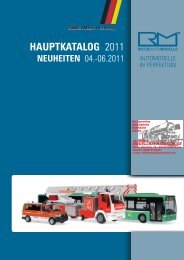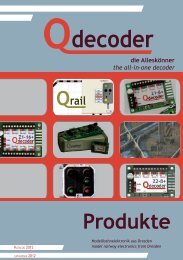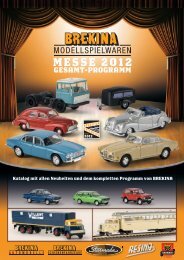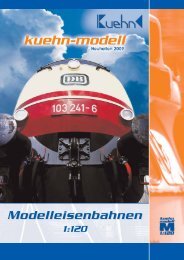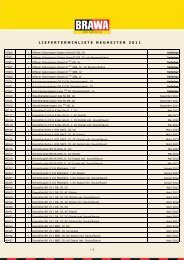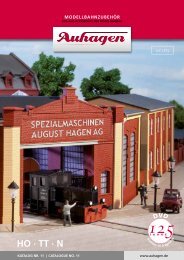Katalog G 2014 - Modellbahnstation
Katalog G 2014 - Modellbahnstation
Katalog G 2014 - Modellbahnstation
Erfolgreiche ePaper selbst erstellen
Machen Sie aus Ihren PDF Publikationen ein blätterbares Flipbook mit unserer einzigartigen Google optimierten e-Paper Software.
PIKO DIGITAL<br />
SOUND-NACHRÜSTUNG VON LOKOMOTIVEN<br />
9 4<br />
Die Gartenbahn-Lokomotiven von PIKO bereiten mit entsprechender Geräusch-Kulisse<br />
noch mehr Freude. Zur Nachrüstung von Lokomotiven gibt es zwei verschiedene<br />
Möglichkeiten: Analog-Sound Kits und Digital-Sound-Module.<br />
Bereits für Einsteiger mit analog betriebenen Dampfloks bietet PIKO zwei Analog-<br />
Sound Kits (36194 und 36221) zur einfachen Nachrüstung. Die typischen Dampflok-<br />
Zylinderschläge werden in Abhängigkeit von der Gleisspannung in mehreren Stufen<br />
an den Sound der entsprechenden Geschwindigkeit angepasst. In Verbindung mit<br />
einer optional einsetzbaren Stützbatterie ist auch eine Soundwiedergabe bei niedriger<br />
Gleisspannung möglich. Neben dem Dampflok-Sound können auch noch die Sounds<br />
einer Lokpfeife und einer Glocke ertönen – sie werden mit Hilfe von optionalen<br />
Gleisschaltmagneten ausgelöst.<br />
Wer seine Gartenbahn-Lokomotiven bereits mit einem PIKO Lok-Decoder digitalisiert<br />
hat, kann jederzeit ganz einfach ein zur Lok passendes Sound-Modul von PIKO<br />
nachrüsten (36190-36193 und 36195-36199). Jedes Sound-Modul enthält typische<br />
Originalgeräusche passend zur entsprechenden Lok. So ertönt beispielsweise bei der<br />
E-Lok der Baureihe 194 beim Ein- bzw. Ausschalten das Geräusch des Hauptschalters. Im<br />
Stand hört man zufallsgesteuert hin und wieder den Lüfter aufheulen. Bei der Anfahrt<br />
ertönt das typische Schaltklacken und beim Abbremsen hört man das Quietschen der<br />
Bremsen. Über separate Funktionstasten lassen sich am digitalen Navigator-Handregler<br />
unter anderem drei verschiedene Lokpfiffe, das Geräusch beim Entkuppeln oder die<br />
Geräusche vom Heben bzw. Absenken des Pantografen abspielen. Auch eine typische<br />
Bahnhofsansage und die Aufforderung zum Abfahren sind auf dem Sound-Modul<br />
enthalten. Unter www.piko.de/sounds können Sie von jedem PIKO Sound-Decoder das<br />
jeweilige Geräusche-Repertoire zur Probe hören.<br />
Der Einbau der PIKO Sound-Module ist sogar noch einfacher, als der Lok-Decoder-<br />
Einbau. Zunächst wird der Lautsprecher mit den Kabeln des Sound-Moduls verbunden<br />
und im Lokboden angeschraubt. Dann wird das vierpolige Schnittstellenkabel mit<br />
Ministecker in die entsprechende freie Buchse des Lok-Decoders gesteckt. Und<br />
abschließend muss nur noch der Decoder mit Hilfe eines beiliegenden Klebepads im Lok-<br />
Inneren fixiert werden. In der Regel sind diese Arbeiten in zehn Minuten locker erledigt.<br />
Erfahrene Digital-Bastler oder auf Digital-Sound-Module spezialisierte Modellbahn-<br />
Fachhändler können die PIKO Sound-Module auch nachträglich individuell umkonfigurieren.<br />
So lassen sich alle im Decoder vorhandenen Geräusche beliebigen<br />
Funktionstasten (F1 bis F28) zuordnen. Außerdem können auch verschiedenste<br />
akustische Effekte realisiert werden. So ist beispielsweise möglich, dass bei aktiviertem<br />
Motorsound immer beim Anfahren automatisch der typische Anfahrpfiff ertönt.<br />
Dampfloks können mit Hilfe eines speziellen Hall-Sensors mit einem Rad-synchronen<br />
Auspuffschlag ausgestattet werden. Bei Diesel- oder E-Loks kann der Hallsensor zur<br />
Realisierung einer Kurvenquietsch-Automatik genutzt werden. Außerdem ist das Sound-<br />
Modul dafür vorbereitet, dass man mit Hilfe eines entsprechenden Programmieradapters<br />
bis zu vier individuelle Geräusche (auf Basis von .wav-Computerdateien) auf den in<br />
Summe 320 Sekunden fassenden Sound-Speicher aufspielen kann – vom Lieblingslied<br />
über eine selbst gesprochene Haltestellenansage bis zum persönlichen Geburtstagsgruß<br />
ist alles möglich.<br />
PIKO garden railway locomotives are even more fun with sound. There are two options<br />
for retrofitting locomotives with sound: analog Sound Kits and digital Sound Kits.<br />
PIKO offers two analog Sound Kits (#36194 and #36221) for easy retrofitting of<br />
locomotives in conventional DC operation. The prototypical chuff sounds change in<br />
multiple steps based on track voltage. An optional power buffer enables continuous<br />
sound even at low track voltages or stand still. In addition to the chuff sound, a whistle<br />
and a bell sound are available. Both can be triggered by track magnets.<br />
If a locomotive is already fitted with a PIKO locomotive decoder, it can be easily<br />
upgraded with the locomotive specific PIKO Sound Kit (#36190-36193 and #36195-<br />
36199). Every Sound Kit plays the prototypical sounds for the corresponding locomotive.<br />
For the BR 194 electric locomotive, for instance, you can hear the main switch when<br />
turning the sound on or off. When the locomotive is sitting idle, the cooling fans will<br />
spin up at random intervals. During acceleration the typical click of the tap-changer can<br />
be heard as well as the brake squeal when coming to a halt. Three different whistles,<br />
the sound when uncoupling from a train and the sounds when lowering or raising a<br />
pantograph can be triggered using function keys on the Navigator Remote. Furthermore<br />
a typical station announcement and the European highball whistle command are<br />
available from the Sound Module. At www.piko.de/sounds you can find sound samples<br />
for all PIKO sound decoders.<br />
Installing PIKO Sound Kits is even simpler than installing the locomotive decoders. First,<br />
the speaker is connected to the cable from the sound module. Then the speaker is<br />
placed on the locomotive main frame and bolted down using the provided screws. Next<br />
the 4-pole interface cable is plugged into the socket on the locomotive decoder. Finally<br />
the sound module is attached to the inside of the body shell with the included doublesided<br />
tape. Usually this can be accomplished within 10 minutes.<br />
Experienced hobbyists or PIKO dealers that specialize in digital operation can customize<br />
the Sound Kit configuration. All available sounds can be assigned to arbitrary function<br />
keys (F1 to F28). In addition, a variety of effects can be configured. For instance it<br />
is possible to have the locomotive sound the whistle whenever it starts moving. For<br />
steam locomotives a hall sensor can be used to synchronize the chuff sound with the<br />
rotation of the wheels. For diesel or electric locomotives the hall sensor can be used to<br />
automatically trigger a wheel squeal sound when negotiating tight curves. Additionally<br />
up to four user-defined sounds (*.wav files) can be added to the sound module memory<br />
using a special programmer. The sound module memory can store up to 320 seconds<br />
of sound samples. With user-defined sounds you can add your favorite song, custom<br />
announcements or a birthday greeting to your locomotive. You are limited only by your<br />
imagination.







